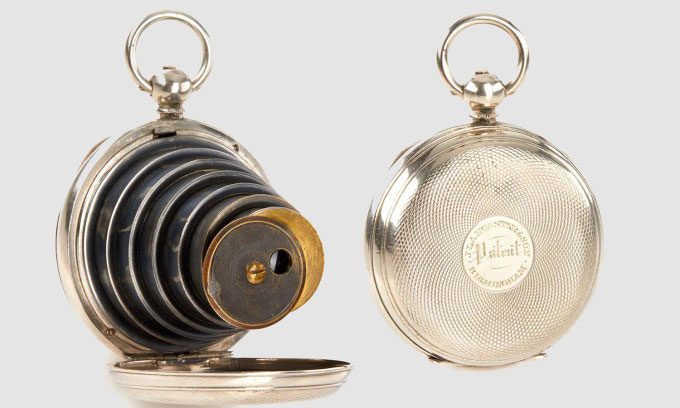The Lancaster Pocket Watch Camera resembles a small round pocket watch, with compact components that can extend to take photographs.
Between 1886 and 1900, the photography company J. Lancaster & Son in Birmingham, England, produced a unique device – the Lancaster Pocket Watch Camera. This device represents a blend of art and innovative engineering. While it may not be a spy camera in the traditional sense, it exemplifies the Victorian fascination with miniaturization and secrecy.

The Lancaster Pocket Watch Camera from the late 19th century. (Photo: Rare Historical Photos)
The brain behind the Lancaster Pocket Watch Camera is James Lancaster, the founder of J. Lancaster & Son. Established in the mid-19th century, this company became known for its photography equipment and contributions to the early development of cameras. Lancaster aimed to create a camera that was not only functional but also portable and discreet.
The Lancaster Pocket Watch Camera looks like a pocket watch with a metal cover protecting the lens, featuring intricate nickel plating and diagonal patterns. Its compact size and elegant appearance make it an accessory that can easily fit in a jacket pocket. The outer round casing of the camera is engraved with the words “J Lancaster & Son Patent Birmingham.”
The most notable feature of the camera is its self-extending mechanism. When opened, it extends six spring-loaded tubes, forming the necessary tube assembly for taking photographs. This feature is not only highly innovative but also showcases the advanced mechanical engineering of the time. In its early versions, the camera included a convex lens along with a simple hand-cranked shutter. As technology progressed, later models were equipped with more advanced shutters.
Despite its impressive design, the Lancaster Pocket Watch Camera posed some challenges in practical use. Users had to remove the frosted glass screen for each exposure by opening four tiny latches and attaching a metal film holder. This process was somewhat cumbersome and required careful handling, making it difficult to take quick or spontaneous photographs.
To address these issues, J. Lancaster & Son released an improved version in 1890. This version featured a larger screen frame and traditional light shields, enhancing user-friendliness but sacrificing some of the original model’s discretion. The introduction of a drop shutter in this model was another notable improvement.
The Lancaster Pocket Watch Camera came in various versions suitable for both men and women. The women’s version was smaller, producing images measuring 3.175 cm x 2.54 cm, while the men’s version was larger, producing images measuring 5.08 cm x 3.81 cm.
The Lancaster Pocket Watch Camera is an important artifact in the history of photography, demonstrating the skilled craftsmanship of the late 19th century. Additionally, this camera model represents an era when technological innovation met practical utility.


















































